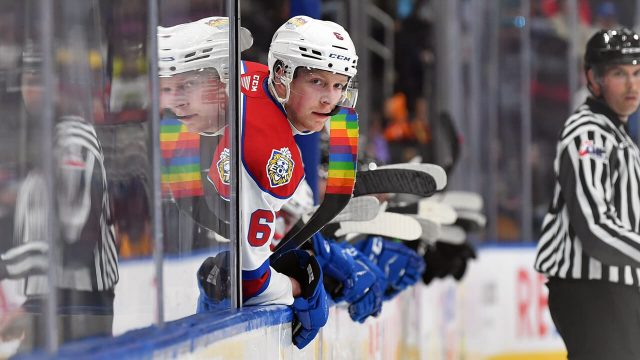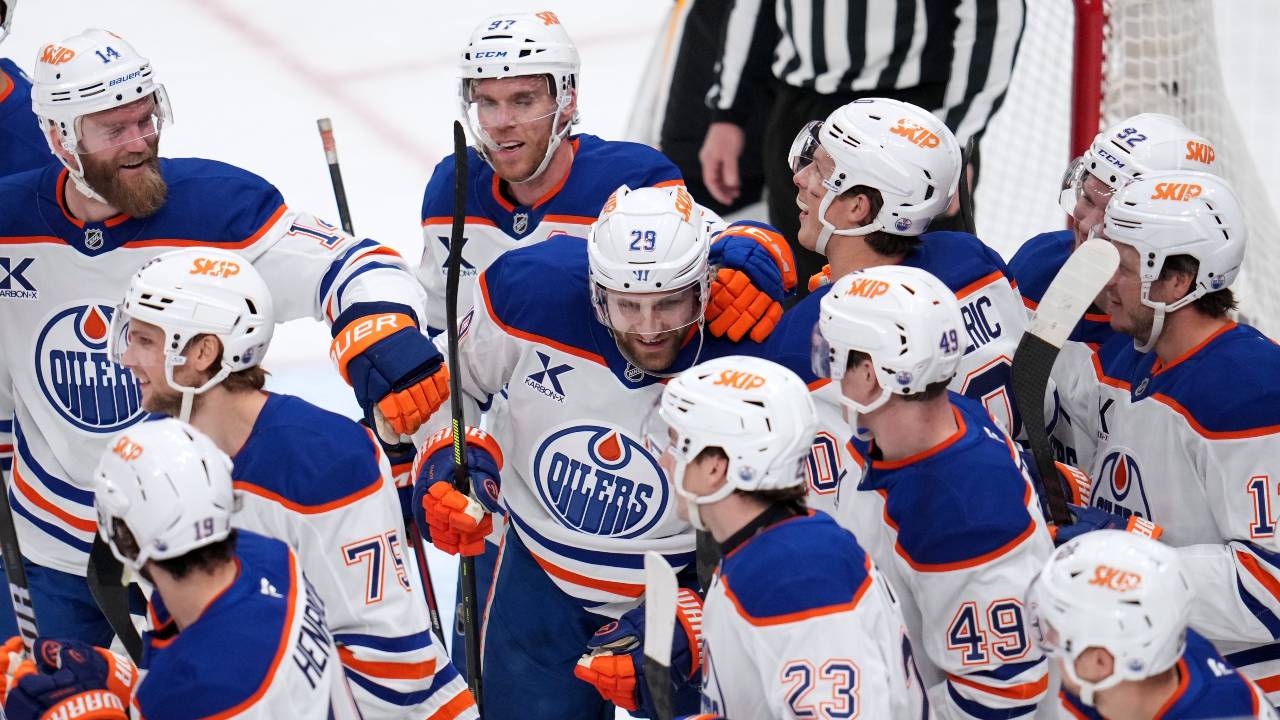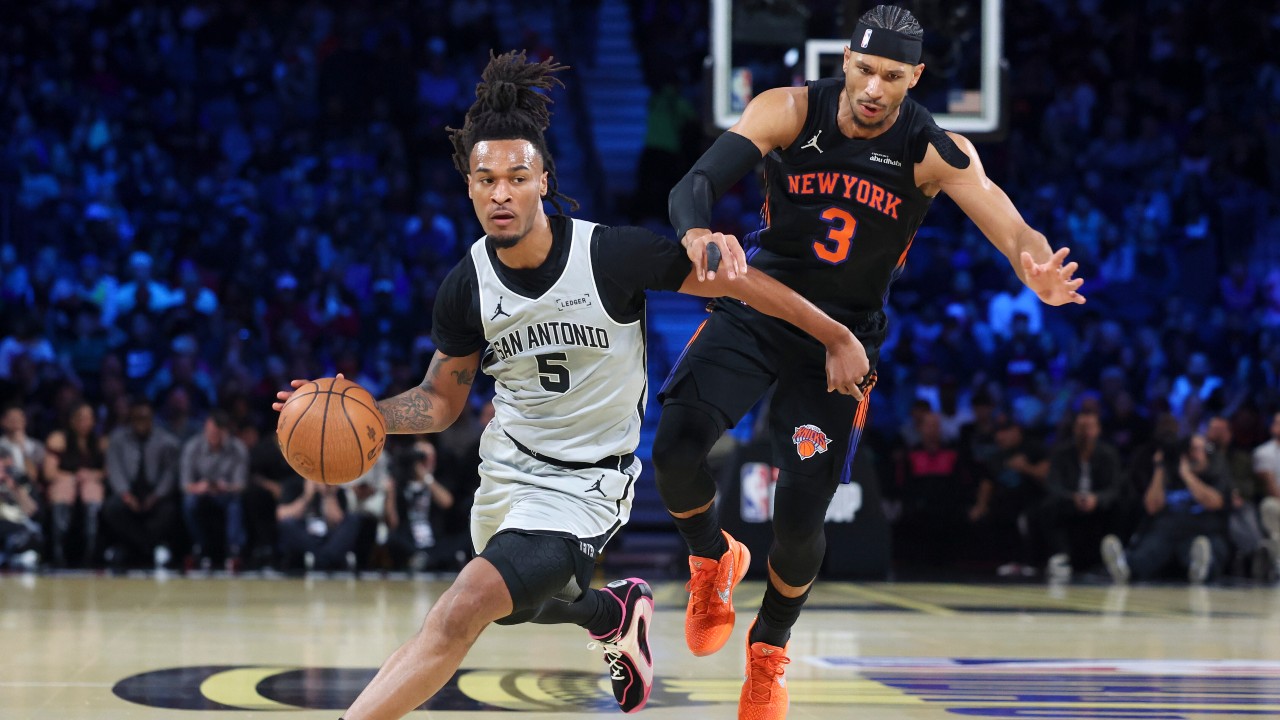
“WHERE ARE ALL THE WOMEN?”
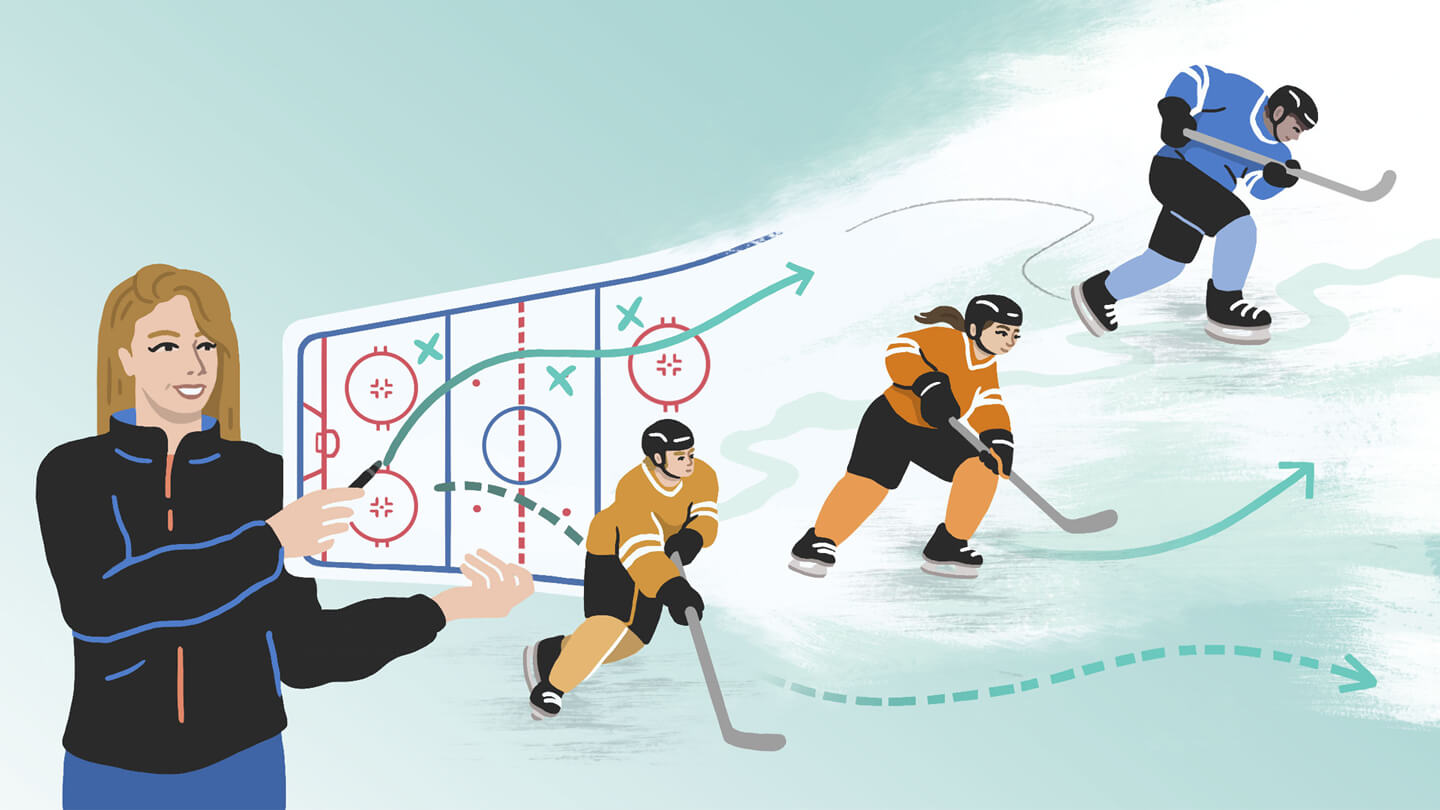
K
im Weiss is sitting in her office at Rockville Ice Arena in Maryland, enjoying a quiet midday moment between the rush of early morning practices and evening skating clinics and games. She grew up here at the rink, a short drive northwest of Washington, D.C. The ice over which her office is perched is where she took her first strides as a young hockey player. Old photos of her in her gear with her dad adorn the wall. She began her coaching career here, too, and her dedication as head coach with the Washington Pride AAA girls teams has helped make the program one of the most respected in the United States. This is her home. Nestled at her feet is her rescue-pup-turned-resident-rink-dog, Gordie Howl. (The yellow lab-cross is as well-known around this arena as Weiss is, but he can’t rival her work ethic; he tends to snooze through practices.)
As she sits here, in May 2021, surrounded by her personal hockey history, Weiss is thinking about her future. “I’ve been in this little bubble for a long time and I love it and I love what I do every day,” she says. “But I think obviously right now is a huge opportunity for women in sports. And I think I’m ready to kind of hopefully be a part of that push forward.”
Weiss knows she belongs on the ice and behind the bench. She’s always had the talent and drive to make coaching her career, but something feels different these days. It’s her confidence and the support system she suddenly has around her, thanks in large part to the NHL Coaches’ Association’s Female Coaches Development Program. The program, now wrapping up its second year, is the brainchild of NHLCA president Lindsay Artkin and was born out of the NHLCA’s mission to expand the traditional coaching pipeline and ensure that as the next generation of coaches is developed at various levels of the game, women are equipped with the resources and opportunities to succeed.
Women have made incredible strides in the hockey world, reaching new heights in the NHL as they take their rightful places in league and team front offices, on scouting squads and in analytics departments, and on the ice in player development roles. But unlike North America’s other three major men’s professional leagues, which have all seen women in sideline coaching positions, we have yet to see a woman take her place behind the bench of an NHL franchise full-time. “If you don’t see women in the NHL, do you think you can go there?” asks Artkin. “Is that even an option?”
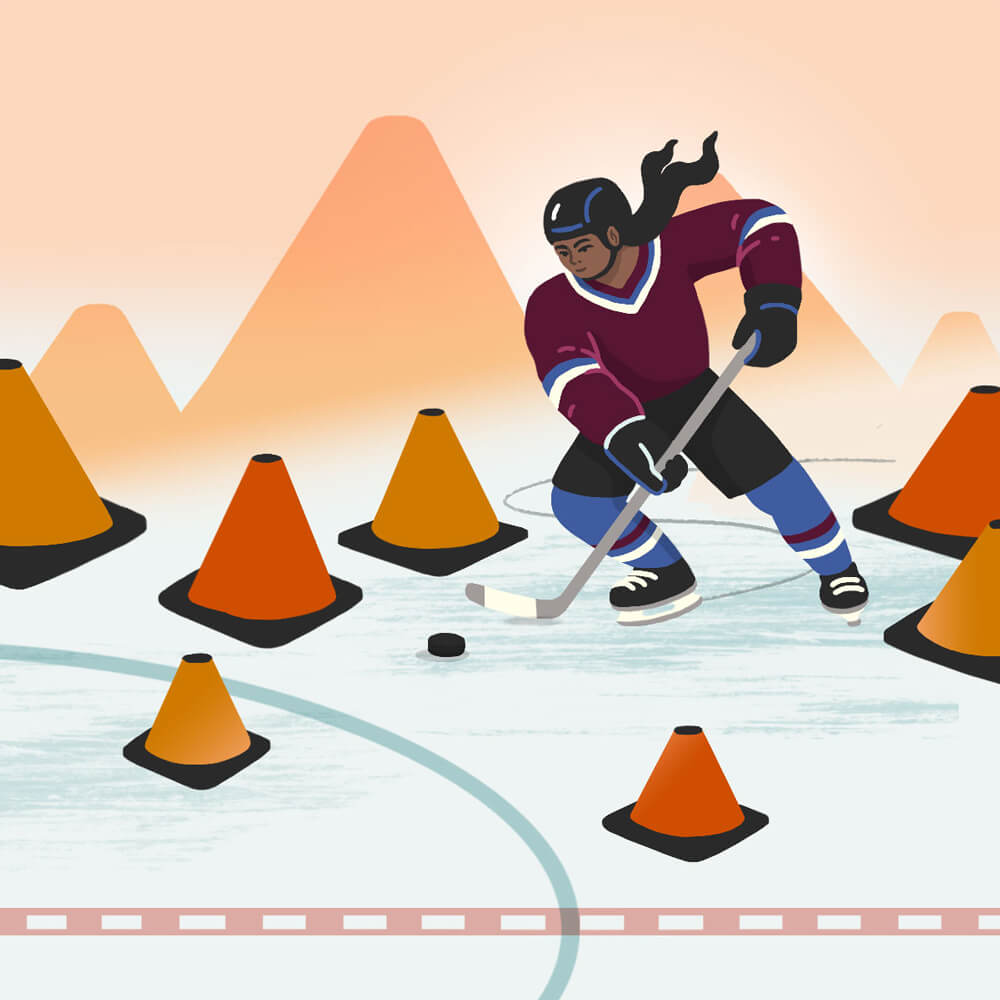
I
t wasn’t so long ago that Artkin was sitting in her own office, thinking of her own professional future. And for her, hockey… well, that wasn’t exactly part of the plan. “You know, I wish I had some great childhood memory of being four and playing pond hockey with my dad and falling in love with it, but I really don’t,” she says.
Artkin’s passion was for math and it propelled her to pursue a commerce degree as a marketing major at McGill University. She knew she wanted to work in finance, and after graduation jumped right in. By June 2012, she’d been named vice president of a billion-dollar investment firm. She was just 28. “I was working 50, 60, 70, 80 hours a week. Finance is a lot — you’re at your desk at 7 a.m., you’re there until after markets close. You’re kind of tied to the market,” she says.
Artkin is curious by nature, a person constantly in search of new challenges. Soon, that drive had her questioning her career path. “I did a decade in finance and was like, ‘Okay, I’ve had success, but am I going to do this for the rest of my life?” she reflects. “This is not inspiring me to get up every day; I haven’t found my purpose or my personal why.” If she was to be putting that much time into something, she thought, she should really love it.
Craving change and seeking that inspiration, Artkin made the move from Toronto to California where she began a new venture with a tech company. While there, she also started up her own consulting business. Then in the fall of 2016, a phone call changed the course of her career.
“Linds! How’s it going? How’s California?”
It was Artkin’s friend and former colleague Michael Hirshfeld on the other end of the line. The two went back about a decade, having worked together at a pair of investment firms in Toronto. Hirshfeld, a lawyer, was up for the role of executive director of the NHLCA, and he’d listed Artkin as one of his references. He cut to the chase: “Okay, so, Mike Babcock’s gonna call you in the next couple hours.”
Artkin laughs as she tells the story, and acknowledges that yes, most Torontonians would have been flustered by a pending phone call from one of the most notable men in the hockey world. At the time, Babcock was the head coach of the Toronto Maple Leafs and the highest-paid bench boss in the NHL. But Artkin, a Leafs fan only “by osmosis” having grown up in North York with limited memories of the club’s early-2000s playoff runs during her high-school days, viewed it as just another professional chat.
At the time, Babcock was a leading voice running the NHLCA. Since its creation in 2001 by a group of veteran coaches led by Scotty Bowman and including Larry Robinson, Roger Neilson, and Pat Quinn, the association has worked to support and assist NHL coaches. During the call, Babcock explained that the association was looking to elevate itself with the help of a sharp business mind — preferably, a fresh voice from outside the hockey world — that could help lead it into the next phase of its existence.
They ended up getting two. The next day, another phone call. Hirshfeld had landed the job, and tasked with transforming the NHLCA and ushering in a new business model for growth, he knew just the person to help.
Artkin took on some NHLCA work in a consulting capacity to start, but it wasn’t long before she jumped in with both feet. She joined the association full-time as president two years later, making the move back home to Toronto. “I thrive, I’ve realized over the past 15 years, in entrepreneurial environments where there isn’t any structure and I get to go in and create that structure and create the direction that we’re going to go in and figure out what the story is and what the messaging is and what we stand for,” says Artkin. “I’ve done that at every firm that I’ve been at, and it was what also attracted me to the NHLCA.”
Since Hirshfeld and Artkin took the helm of the NHLCA, the association has grown in profile and in membership — from less than half of NHL coaches enrolled to a full 100 per cent. It has also expanded to include AHL coaches, overseeing and supporting the needs of around 350 members across North America. Unlike the NHL Players’ Association and Alumni Association, the NHLCA isn’t a union but rather a non-profit organization in place to help coaches with everything not related to hockey operations — pensions and benefits, contracts and immigration issues, and all other off-ice issues that might affect their well-being or require a unified voice speaking on their behalf. “They don’t need another hockey voice — we’ve got 200 NHL coaches who can share their hockey opinion,” Artkin says. “We need business leaders to make it a real business.”
Once Artkin, Hirshfeld and the members of the NHLCA board felt good about the foundation they’d set in place, the organization began a very important mission: “We said our goal is to develop the next generation of NHL coaches,” says Artkin. “There are many different tracks you can go down: What does that mean? Where are we focused? And that’s where my role has really been … putting all of that into place.”
Once again, her curiosity fuelled the mission. And in June 2019, as she scanned a room of mostly male coaches from across North America at the NHLCA’s annual Global Coaches’ Clinic, which brings in aspiring pros from across the sport, she had a lightbulb moment as she zeroed in on one crucial question: Where are all the women?

L
ee-J Mirasolo was in Naples, Fla. when her lightbulb moment came.
The Harvard women’s hockey associate head coach was attending a presentation given by then-Winnipeg Jets assistant Todd Woodcroft at the 2019 American Hockey Coaches Association (AHCA) Convention, and was struck by the repeated use of one simple word: She.
“He kept using the pronouns she or he, she or he, she or he,” Mirasolo says. “And not only that, but he also had pictures in his slides of women’s hockey players — not just men’s hockey players, not just NHL players.”
A decade of learning from more experienced coaches without ever hearing or seeing herself represented in the presentations at these events had made her feel like women were (intentionally or not) viewed as a second thought in coaching circles — if they were thought of at all. “It’s the whole idea of visibility and representation — which aren’t enough, in general, but in this case it was so amazing to feel like we were supposed to be there,” she says. “I’ve been coming here for 10 years and I’ve never had a men’s coach go up and use multiple pronouns.”
Mirasolo told Woodcroft as much, thanking him later via email for his presentation and the inclusive language and imagery within it. The message sparked a correspondence, and Woodcroft soon suggested she speak with Artkin about a new program the Coaches Association was doing some research for.
“It was a great conversation,” Mirasolo says of that first chat with Artkin. “It was obvious that she had a ton of passion for this and a ton of curiosity. She wanted to know about our experience, wanted to know what our needs were. And I think because of that, she just really listened.”
Mirasolo connected Artkin with more women, who gave her more insights, as she continued her fact-finding mission in hopes of developing a program that would elevate women in the game. She spoke with NHL coaches, inquiring about their own networks and whether they could connect her with any female coaches in their circles. She cast her net far and wide, making sure to seek coaches on both sides of the border and at all levels of the game, from hot hockey markets to smaller, less traditional ones. Throughout the process, she’d gathered about 60 hours’ worth of intel from female coaches, compiling notes and connecting dots.
“I just started hearing the same things over and over and over in terms of societal norms and pressures, unconscious biases, hockey challenges, general career advancement issues,” says Artkin. “So I’m like, ‘Okay, I feel like I’m starting to see the landscape of what it’s like to be a woman coaching hockey across North America.”
T
he landscape shifted for Cassie Turner in her freshman year at Brown University, the first time in her life she had a female head coach. It didn’t take long for the defender to understand just how much this new experience would shape her hockey journey. That coach was Margaret “Digit” Murphy. Murphy, says Turner, became a mentor. And she quickly recognized that Turner was already studying the game like a coach. “As a player, I loved the intricacies of the game, the little things that make such a big difference. I loved to think about the game and how things work and how teams play. And I didn’t even realize how I thought about it then,” says Turner.
It’s easy to look at hockey’s coaches through the same lens we view its players, applying the idea that one toils away in developmental leagues with the singular goal of going “pro” someday — and that is simply not the case. While there is an obvious need for greater diversity within NHL organizations and their AHL affiliates, Artkin is careful not to label the NHL as the pinnacle of success when it comes to coaching.
This is something Turner understands well. “Somebody who would be a phenomenal youth hockey coach isn’t always going to be a great NHL coach and vice versa. It’s such a different skillset wherever you go,” says Turner, adding with a laugh that, “I think I might be a terrible youth hockey coach.”
In gathering intel and putting out a call to NHL and NCAA teams to nominate women to participate in the first year of the Female Coaches Development Program, Artkin purposely sought women from all parts of the game and with different career aspirations. The program currently includes nearly 60 women, coaching at levels ranging from high-school clubs to top-tier women’s college squads, local leagues to national teams. “We didn’t just want a group of women that want to coach in the NHL. Yes, there needs to be change at that level, but there also needs to be change at every other level leading up to it — all of the developmental leagues, certainly on the men’s side of it, too, but even on the women’s hockey side, the NCAA side of it,” says Artkin. “There are so many other barriers holding women back.”
Turner, who has now completed her 13th season, and seventh as head coach, with the Division-I Quinnipiac University women’s hockey program, knew right from the start that she wanted to coach women’s college hockey. And she hopes to pay it forward like Murphy did for her. “There’s nothing that makes me happier than to see my alums out and coaching little girls,” she says. “Because they need to see that women can do this, and that they don’t get to college and have their first female coach like I did.”
And while she’s earned every last bit of her success with the Bobcats, Turner still counts herself as one of the lucky few. She was six months pregnant when she was named head coach — a promotion that suddenly saw her entire livelihood change, giving her the kind of stability that few women see in this profession. Long-standing gender biases in coaching mean there are significant obstacles for women at every level, but Turner points out some hurdles unique to the college game — a notoriously unstable profession to begin with. “I think a lot of it is just the ability to have this be a career that is sustainable. So, if you are a young female, how do you do this and meet the aspirations of your partner and where you’re going to live? And can you move around that much if you need to? What’s your responsibility once you have children – do you feel you can have children? Do you make enough money to then pick up your family and move if you need to move?” she explains. “Not everyone gets to be as lucky as me, you know? And so, we’ve lost a lot of women in college coaching because of that.”
With more eyes on women’s college hockey these days, expectations have risen faster than salaries, making those jobs even more volatile at times. And when salaries have jumped, more men have begun vying for those better-paying positions, once again placing them out of reach for many qualified first-time female head coaches.
Nestled within this issue, of course, is the double-standard that dictates that while men can coach both men’s and women’s hockey, women can only coach women. It’s a belief that has meant the vast pool of job opportunities for men shrinks to a puddle for women with equivalent qualifications.
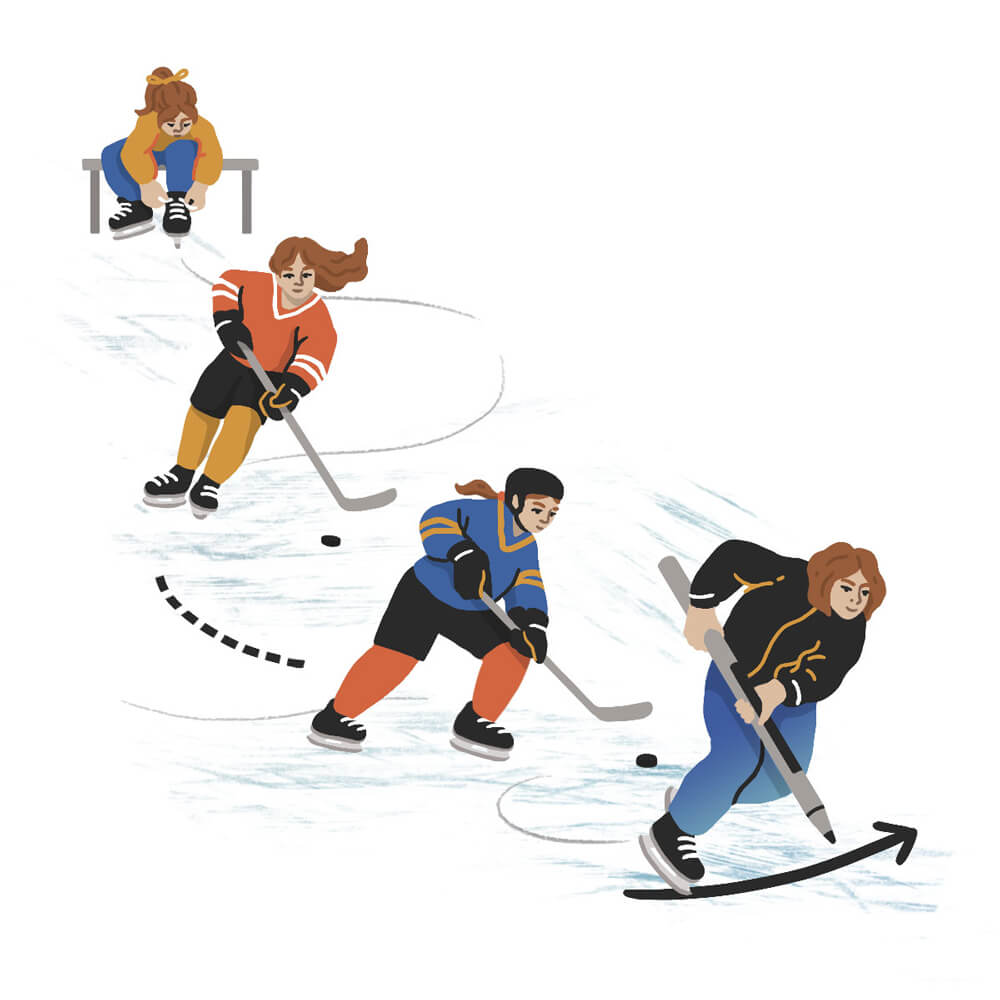
B
y March 2020, Artkin was ready to announce the launch of the Female Coaches Development Program, built on three key principles: networking and relationship building, professional development, and visibility and exposure. She’d put out a call to every NHL club to introduce the idea and asked teams to nominate one or two women from their markets who might be interested in participating.
The first cohort was to kick off that June at the annual NHL Draft Coaches Clinic — one year to the day after Artkin’s “ah-ha moment.” But one week after making these plans public, the COVID-19 pandemic shut down everyday life, taking with it the remainder of hockey seasons across the globe and the hope of any in-person events for the foreseeable future.
The rollout, Artkin realized, had to be entirely rethought.
Already well-versed in all things Zoom thanks to some global mentorship sessions she’d recently organized online for another pilot program — “I basically taught every NHL coach how to Zoom,” she says with a laugh — it only made sense to Artkin to host the Female Development Program online, too. She started with a four-week pilot in partnership with the American Hockey Coaches Association’s women’s hockey group and a handful of NHL coaches who stepped in as mentors.
One of those coaches was Edmonton Oilers assistant Glen Gulutzan. Gulutzan tells a story from his ECHL days about asking veteran coach Darryl Sutter what it would take to break into the NHL. Sutter was in the midst of his first tenure behind the bench of the Calgary Flames, and Gulutzan was coaching the franchise’s affiliate, the Las Vegas Wranglers. “I remember Darryl’s answer to this day: It was, ‘Well unfortunately, Glen, it’s not how good you do at your level all the time — it’s more of who you get to know that can help you along the way,’” Gulutzan says. “And I, as a young coach, was like, ‘If I just keep winning, people are gonna grab me.’ But that’s not necessarily the case. You had to try to create a network, you had to do well, you had to develop players, but the biggest thing over the years that’s now come into mind for me is that network you create. So, I see the value of this program firsthand because of the network I was able to create as a young coach.”
Winnipeg Jets assistant Jamie Kompon also knows the value of a network and the development program. He doesn’t take the mentors who’ve helped him forge a 23-year NHL career for granted, and he jumped at the chance to play a similar role for women looking to further their knowledge and skills. “It’s just continuing to open doors,” says Kompon. “I get excited talking about it, because someone took the time for me as a young coach, to help mentor me to be where I am today. And so I’ve got to make sure that I’m doing the same.”
Kompon was partnered up with Turner during the pilot and tasked with putting together a pair of presentations for a group of college coaches. Since first collaborating, the two have stayed in touch, checking in, busy schedules allowing, about once a month. “Now, he’s a friend. He’s somebody who I message about different things, and we’ve gotten on a number of different calls together and talked about different things,” Turner says. “He’s been a true mentor and he’s helped me exponentially. … I’m going to have somebody now that I can truly trust and rely on to be able to ask questions to get awesome help. He’s outstanding.”
The bonds created between coaches — spanning different leagues, genders and backgrounds — serve as perfect examples of why Artkin believes the conventional idea of mentorship needs to be adjusted “to be circular, in a sense where it is like a relationship.
“It continues to evolve because as a coach, you never stop learning,” she continues. “And so, I think you’re always in a role of being both a mentee and a mentor.”
Says Kompon of his experience in the program: “When we started this, I learned more from them than they probably learned from me. Just listening to what they do and how their days go and how they built their programs, and what they’ve done … it was just phenomenal to get to know them.”
Armed with the learnings from the pilot session and brimming with ideas, Artkin launched the program in August 2020. In its first year, she found that with the costs, travel, and time commitments of in-person events stripped away, she was able to deliver more. The results exceeded the expectations she’d brought in.
She enlisted the help of NHL and AHL coaches, breaking the sessions off into smaller groups using Zoom rooms to allow for more focused conversations to talk hockey, exchange contact info, and encourage the women to build networks beyond their usual circles. She brought in guest speakers like Hockey Canada legend Mel Davidson and the great Cammi Granato, and empowered the group members themselves to put together presentations. She also leveraged NHLCA partnerships to fully equip all 50 women — 40 nominated by NHL franchises and 10 from the AHCA’s network — with free access to online resources like Coaches Site, Coach Them drill-drawing software, InStat Hockey, and a pass to the NHLCA’s annual Global Coaches Clinic (now online).
When the NHL returned, post-bubble, in January 2021, Artkin collaborated with the Anaheim Ducks and Arizona Coyotes to give the women a glimpse into what goes on in an NHL training camp. Ducks head coach Dallas Eakins gave them fly-on-the-wall access to staff meetings and video review sessions for a day, followed by an extensive Q&A. “These programs wouldn’t be possible if [NHL coaches] weren’t putting up their hands to say, ‘Yes, I want to be involved with this networking session, I want to do this presentation. Yes, let me connect with that coach,’” says Artkin. “And they’re excited that we’ve got this up-and-coming talent pool that they themselves can be connected with and learn from and hopefully, you know, continue to help their teams down the road, too. That’s honestly been one of the most fun things for me as well, is just seeing our NHL guys get excited to be connected with the women in the program as well.”
The timing of it all, says Turner, couldn’t have been more perfect.
“I just feel like it’s been such a good introspective year where people are evaluating what they want, why they’re doing what they do,” she says. “It’s really been nice. I see people let their guard down and great conversations really come with this group. I’m excited, because I think it’s going to create a ripple and continue to get more women in coaching at the youth level, at our [college]level, and I do think it would be so amazing to see a female as an assistant coach — to start! — of an NHL program. And I think we have women who are capable. It’s just finding the organization and the opportunity that’s right.”

O
ne year later, Kim Weiss is in Quebec City, her voice hoarse and hands full as she wrangles a team of 12-year-old boys through the Quebec International Pee-Wee Hockey Tournament as head coach of the u-13 AA Atlantic Selects. Since joining the NHLCA program, opportunities have opened up for Weiss that she never would’ve even known about previously, let alone felt empowered to apply for. “I think my confidence has just kind of ballooned as a coach, because you have this army now of women across the country — and really, almost across the world — that are in your corner,” says Weiss. “As a female in a very male-dominated industry, to now have a lot more allies on our side is awesome.”
Last spring, a woman in the program texted her about a Division-I men’s opportunity, and Weiss applied and interviewed. Women, she notes, are notorious for not applying for men’s coaching jobs. She didn’t land the college job, but as fate would have it, opportunity came knocking soon after right in her own backyard with the Maryland Black Bears of the North American Hockey League, a USA Hockey-sanctioned Tier-II junior men’s league based in nearby Odenton. She’d previously helped out with the team in various capacities, working with some of the players on the ice and lending her knowledge during evaluation camps and other sessions.
Realizing she was open to coaching opportunities outside of the Pride, Black Bears head coach and general manager Clint Mylymok wasted no time offering her a job on his staff last June. When she accepted one day later and assumed the role of assistant coach with the club, she made history as the first woman named to a bench coaching position in men’s junior hockey in North America. “It was kind of interesting how when one door closes, another door opens,” says Weiss of the experience. “Having the NHLCA, and the connections that you make through it and the people you talk to … it gave me the confidence to say yes, to step into the role knowing that I was enough, I didn’t have to change who I was or what I needed to do.”
She’s seen how the coaching landscape, particularly the path to the NHL, has changed of late. As a kid, she had to confront the reality that she wouldn’t play in the NHL someday. As a coach, though, she acknowledges that the dream now has space to live on. “When I was younger, it seemed so unattainable. It just didn’t seem realistic. Obviously, you don’t see any women on [NHL] benches, and so it didn’t seem like that was a possibility,” she said. “But that could be me.”
When she thinks about her future now, she sees a path ahead. “I love what I do every day … I’ll definitely coach hockey for the rest of my life. I can feel confident in saying that,” she says. “I don’t have a ‘normal-person job.’ I just put on my skates and tracksuits. I can tell you in five years I’ll be on the ice coaching players. I can’t tell you if that’ll be boys or girls, adults, children. But I can definitely say that I’ll be in the game.”
W
ith Year Two of the program now in the books, Artkin’s work is far from done. She has plans already in motion to expand the program to incorporate one-on-one, in-person job shadowing opportunities next season in partnership with NHL franchises — an opportunity that will also include members of the NHLCA’s BIPOC Coaches Program, which runs along the same timeframe.
Artkin admits her tendency to zero in on the day-to-day has prevented her at times from pausing to look around. If she did, she’d see a landscape with fewer hills to climb and more pathways in — with more women walking them.
Within the past few weeks alone, two women — both of whom have been part of the NHLCA’s female coaches development program since its inception — have made coaching history in men’s professional hockey. First, the Washington Capitals promoted Emily Engel-Natzke to be their video coordinator after she spent the past two seasons as a video coach with their AHL club in Hershey. The hiring made Engel-Natzke the first woman to join an NHL coaching staff full-time. Just a few days later, Jessica Campbell made history as the first female assistant coach in the AHL when she was hired by the Coachella Valley Firebirds, affiliate of the Seattle Kraken. Elsewhere around the league, teams are bringing in women as guest coaches during development camps and as player development consultants.
Earlier this month, Artkin was in Montreal, host city for the 2022 NHL Draft, where after a two-year pause the NHLCA once again brought together coaches from many walks of life for some special in-person networking events. And this time, when she looked out at the sea of faces there, she saw women looking back at her. “I think my biggest takeaway is that these women feel heard. They feel that their perspectives and their opinions matter. That they are validated within the coaching community, and that finally something has started to be done for female coaches. So, that’s incredible,” she says. “I’m so humbled that’s the reaction.”
Says Mirasolo: “There are women who are getting jobs in in men’s hockey now that is a direct result of what Lindsay is doing. And whether it’s the actual program or her bringing visibility and education and awareness to men’s hockey, to the NHL specifically, there’s no question that it is a direct result of Lindsay Artkin and the NHLCA women’s mentorship program.”
Artkin found her why. And she’s also found her how. Now, with an eye to women breaking into NHL coaching, the question is simply a matter of when.
Illustrations by Caitlin Taguibao. Photos courtesy Lindsay Artkin.



